
|
Laser Diffraction Sensors |
| Overview |
| HELOS |
| MYTOS |
| MYTIS |
|
Dispersing Units |
| OASIS/L |
| OASIS/M |
| RODOS |
| RODOS/M |
| RODOS/L |
| GRADIS/L |
| SUCELL |
| QUIXEL/L |
| CUVETTE |
| SPRAYER |
| INHALER |
|
Software |
| WINDOX 5 |
|
Accessories |
| Computer |
| VIBRI/L family |
| VIBRI family |
| ASPIROS/L |
| ASPIROS |
| MULTI- SAMPLER |
| Extraction Units |
| LIQIBACK |
| SVA |
| ROTOR/L |
|
Information |
| Publications |
Over the past 30 years Laser Diffraction has developed into the leading principle for particle size analysis of all kinds of aerosols, suspensions, emulsions, and sprays in laboratory and process environments.
The diffraction of the laser light results from the interaction of the light with the particles and can be described mathematically by Fraunhofer or Mie theory. For a single spherical particle, the diffraction pattern shows a typical ring structure. The distance r0 of the first minimum to the centre is depending on the particle size, as shown in fig. 1 and fig. 2. The acquisition of the intensity distribution of the diffracted light is usually performed with the help of a multi-element photo-detector, as displayed in fig. 3.
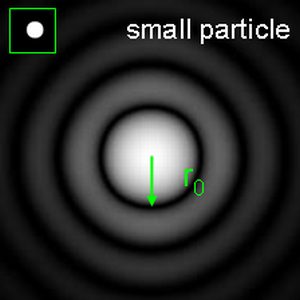 |
 |
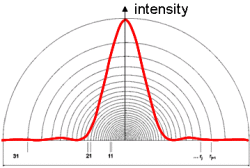 |
|
Fig. 1: Diffraction pattern of a small particle |
Fig. 2: Diffraction pattern of a larger particle |
Fig. 3: Intensity distribution of a small particle detected by a semi-circular photo-detector. |
Simultaneous diffraction on more than one particle results in a superposition of the diffraction patterns of the individual particles as long as the particles are moving and the diffraction between the particles is averaged out.
In 1983 Sympatec has pioneered in evaluating the size distribution with a parameter free and model independent mathematical algorithm. This has been accomplished with the introduction of the Phillips-Twomey algorithm for the inversion process.
Basing on the physical principles of laser diffraction, Sympatec has introduced the particle size analysers HELOS for laboratory and MYTOS for process applications with emphasis on the following features:
As the intensity of the diffraction pattern is very low and smallest uncertainties would result in large errors in the volume distribution Q3(x) it is important to get the best possible intensity data before applying the inversion algorithm.
| 1. | Sympatec is using a HeNe-laser of 632.8 nm with a long resonator, and a sophisticated spatial filter in the beam expansion unit to create an almost perfect plane wave for the illumination of the particles. | |
| 2. |
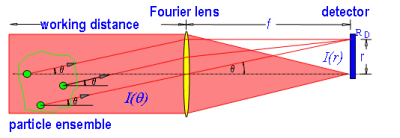 |
|
| 3. | The quality of the Fourier lens defines the precision of conversion of the angle q of the diffracted light into the radius r. Optical modules of highest quality are used containing up to 10 lenses to achieve the necessary precision in up to eight widely overlapping measuring ranges. | |
| 4. | Not all particles are spherical but all diffraction patterns are symmetric to 180°. This is why Sympatec is using a multi-element photo detector with semi-circular rings, which exactly integrates over 180°. So the results become independent of a systematic orientation of the particles, e.g. by the dispersing fluid. | |
| 5. | The intensity and its spatial distribution has to be measured with highest possible precision. A detector of latest technology is used, which is specially designed and manufactured for Sympatec showing outstanding features: e.g. highest linearity and homogeneity, zero reflection, zero crosstalk, lowest noise, fast. | |
| 6. | Tiny photo-currents have to be acquired with the detector. External electronic noise may be introduced from subsequent stages or the PC. Sympatec is using special high speed digital isolators for complete isolation. | |
| 7. | A stable optical bench of extruded aluminium profile in combination with a metal housing and the auto-alignment unit keeps the centre of the detector perfectly in the optical axis. The operation of the sensor in any orientation thus is possible. Quality and stability of this set-up is demonstrated with the maximum possible particle size: This is 8750 µm, a unique value for a particle size analyser using laser diffraction. |
| 8. | If particles stick together laser diffraction measures the size of the agglomerate rather than the size of the primary particles. So the complete dispersion of the sample is of decisive importance. The HELOS family offers an open measuring zone of 123 mm width (HELOS-VARIO up to 1.4 m). Here dispersers for dry powders, suspensions, aerosols and sprays can be easily mounted allowing for an optimum adaptation of the laser diffraction sensor to the sample - dry samples should be analysed in dry state, wet samples should be analysed in wet state. |
| 9. | HELOS and its dispersers are completely modular. Extensions of the measuring range with additional range modules, adaptations to new applications with supplementary dispersers or the accessories are possible at any time. |
Our laser diffraction systems fulfil the quality requirements of the Pharmaceutical industry.
They are compliant with ISO 13320-1 and CFR 21 rule 11.
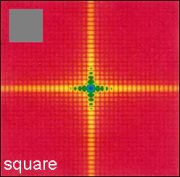


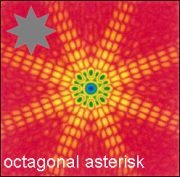

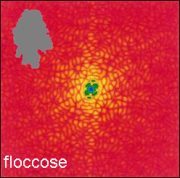
Calculated diffraction patters for non-spherical particles (please refer to the grey particle shape in the corresponding image).
All patterns show a symmetry of 180°.